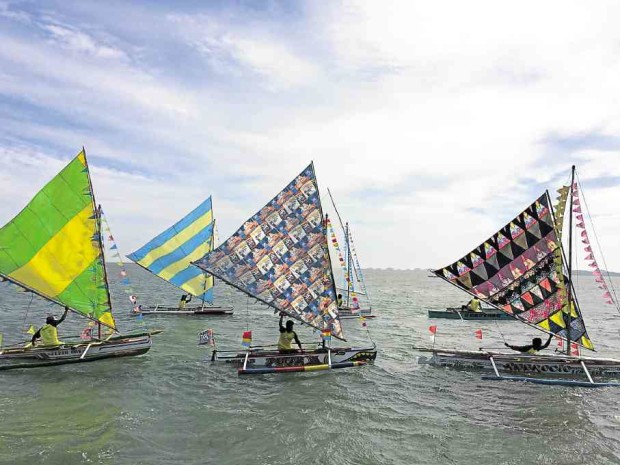
“Paraw,” the indigenous monosail fishing vessels of Alaminos City and its neighboring coastal towns, sail at the Lu cap Bay during the launching of Paraw Festival on March 28. —YOLANDA SOTELO
ALAMINOS CITY—On a dark, starless night, the wind blows on Lucap Bay, sending small boats called “paraw” to sway with the waves, their “lampara” (kerosene lamps) flickering like fireflies and sails fluttering like butterflies in the breeze.
It was a scene recreated from the past, muted only by the fact that the paraw actually carry poor fishermen who use hook-and-line to make a living in this coastal city which hosts the popular tourist destination, Hundred Islands National Park.
On March 28, Alaminos launched the Paraw Festival to recapture the days when the city thrived on farming and fishing, and fishermen used sailboats that were indigenous to the place and neighboring coastal towns.
The boats swirled with the bay wind and stopped in front of Lucap Wharf as a voice from the loudspeaker narrated the history of paraw.
“Those were the days when people here were either farmers or fishermen. Little was known about tourism. They were not aware that the Hundred Islands would be manna from heaven that could propel the economy of the city,” tourism officer Mike Sison said.
Booming tourism
As the city earns from a booming tourism, the fishermen in paraw have been left behind to depend on their daily catch, which has diminished through the years.
Maneuvering the sail while manipulating their simple fishing gear is still a way of life for hundreds of fishermen like Dominador Pacalan, 68; and his wife Carmencita, 65, of Barangay Lucap.
Couple Dominador and Carmencita Pacalan are original “paraw” owners, operating the monosail boat since their courtship days. — YOLANDA SOTELO
Pacalan’s eyesight has been failing him and he needs the help of his wife, who also suffers from hypertension.
“When she says she is not feeling well, we have to go back to shore,” he said. “It is our only means of livelihood as we have no land to till. But the paraw is already old and full of holes which we sealed with epoxy.”
Two of their children also take the paraw out to the open sea to fish. They usually leave the wharf at 8 a.m. after buying shrimps for bait.
If they buy the bait in the afternoon, they can sail out at dawn the next day and return before noon with three or four kilograms of assorted fish.
Difficult livelihood
Delfin Domenden, 70, said the catch could at times be less, especially when fishing during full moon.
“It’s a difficult means to earn a living. But we are still thankful that the sea, most of the time, can be generous,” said Domenden, who learned how to sail the paraw when he was 9 and returned to Alaminos after working as a machine operator in Manila.
Mayor Arthur Celeste said the city wanted the fishermen to benefit from the influx of tourists by offering paraw rides around the bay, to the sprawling mangrove forest or the hundred islands, for a fee.
The fishermen operate 125 paraw, 50 of them donated by the Department of Labor and Employment and the sails by Pioneer Adhesives Foundation Inc. The boat can carry four passengers—the operator, helper and two tourists. A 30-minute ride costs P150.
“If you ride the paraw, you do not only enjoy the ride and learn how to direct the boat using the sail; you also help at least 50 fishermen and their families,” Celeste said.
A “school” for paraw sailing will be put up for those who want to learn it.